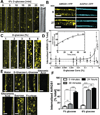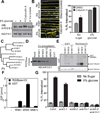Endocytosis of the seven-transmembrane RGS1 protein activates G-protein-coupled signalling in Arabidopsis
- PMID: 22940907
- PMCID: PMC3463750
- DOI: 10.1038/ncb2568
Endocytosis of the seven-transmembrane RGS1 protein activates G-protein-coupled signalling in Arabidopsis
Abstract
Signal transduction typically begins by ligand-dependent activation of a concomitant partner that is otherwise in its resting state. However, in cases where signal activation is constitutive by default, the mechanism of regulation is unknown. The Arabidopsis thaliana heterotrimeric Gα protein self-activates without accessory proteins, and is kept in its resting state by the negative regulator, AtRGS1 (regulator of G-protein signalling 1), which is the prototype of a seven-transmembrane receptor fused with an RGS domain. Endocytosis of AtRGS1 by ligand-dependent endocytosis physically uncouples the GTPase-accelerating activity of AtRGS1 from the Gα protein, permitting sustained activation. Phosphorylation of AtRGS1 by AtWNK8 kinase causes AtRGS1 endocytosis, required for both G-protein-mediated sugar signalling and cell proliferation. In animals, receptor endocytosis results in signal desensitization, whereas in plants, endocytosis results in signal activation. These findings reveal how different organisms rearrange a regulatory system to result in opposite outcomes using similar phosphorylation-dependent endocytosis mechanisms.
Figures







Similar articles
-
Direct Modulation of Heterotrimeric G Protein-coupled Signaling by a Receptor Kinase Complex.J Biol Chem. 2016 Jul 1;291(27):13918-13925. doi: 10.1074/jbc.C116.736702. Epub 2016 May 27. J Biol Chem. 2016. PMID: 27235398 Free PMC article.
-
JA-Induced Endocytosis of AtRGS1 Is Involved in G-Protein Mediated JA Responses.Int J Mol Sci. 2019 Aug 2;20(15):3779. doi: 10.3390/ijms20153779. Int J Mol Sci. 2019. PMID: 31382426 Free PMC article.
-
AtRGS1 function in Arabidopsis thaliana.Methods Enzymol. 2004;389:338-50. doi: 10.1016/S0076-6879(04)89020-7. Methods Enzymol. 2004. PMID: 15313575 Review.
-
Ligand-induced dynamics of heterotrimeric G protein-coupled receptor-like kinase complexes.PLoS One. 2017 Feb 10;12(2):e0171854. doi: 10.1371/journal.pone.0171854. eCollection 2017. PLoS One. 2017. PMID: 28187200 Free PMC article.
-
Glucose signaling, AtRGS1 and plant autophagy.Plant Signal Behav. 2019;14(7):1607465. doi: 10.1080/15592324.2019.1607465. Epub 2019 May 6. Plant Signal Behav. 2019. PMID: 31055999 Free PMC article. Review.
Cited by
-
Cell-free translation and purification of Arabidopsis thaliana regulator of G signaling 1 protein.Protein Expr Purif. 2016 Oct;126:33-41. doi: 10.1016/j.pep.2016.04.016. Epub 2016 May 6. Protein Expr Purif. 2016. PMID: 27164033 Free PMC article.
-
Extra-Large G Proteins Expand the Repertoire of Subunits in Arabidopsis Heterotrimeric G Protein Signaling.Plant Physiol. 2015 Sep;169(1):512-29. doi: 10.1104/pp.15.00251. Epub 2015 Jul 8. Plant Physiol. 2015. PMID: 26157115 Free PMC article.
-
Eukaryotic G protein signaling evolved to require G protein-coupled receptors for activation.Sci Signal. 2013 May 21;6(276):ra37. doi: 10.1126/scisignal.2003768. Sci Signal. 2013. PMID: 23695163 Free PMC article.
-
Sugar-induced endocytosis of plant 7TM-RGS proteins.Plant Signal Behav. 2013 Feb;8(2):e22814. doi: 10.4161/psb.22814. Epub 2012 Nov 15. Plant Signal Behav. 2013. PMID: 23154506 Free PMC article.
-
Photosynthate Regulation of the Root System Architecture Mediated by the Heterotrimeric G Protein Complex in Arabidopsis.Front Plant Sci. 2016 Aug 25;7:1255. doi: 10.3389/fpls.2016.01255. eCollection 2016. Front Plant Sci. 2016. PMID: 27610112 Free PMC article.
References
-
- Kohout TA, Lefkowitz RJ. Regulation of G protein-coupled receptor kinases and arrestins during receptor desensitization. Mol Pharmacol. 2003;63:9–18. - PubMed
-
- Hanyaloglu AC, von Zastrow M. Regulation of GPCRs by endocytic membrane trafficking and its potential implications. Annu Rev Pharmacol Toxicol. 2008;48:537–568. - PubMed
Publication types
MeSH terms
Substances
Grants and funding
LinkOut - more resources
Full Text Sources
Other Literature Sources
Molecular Biology Databases

